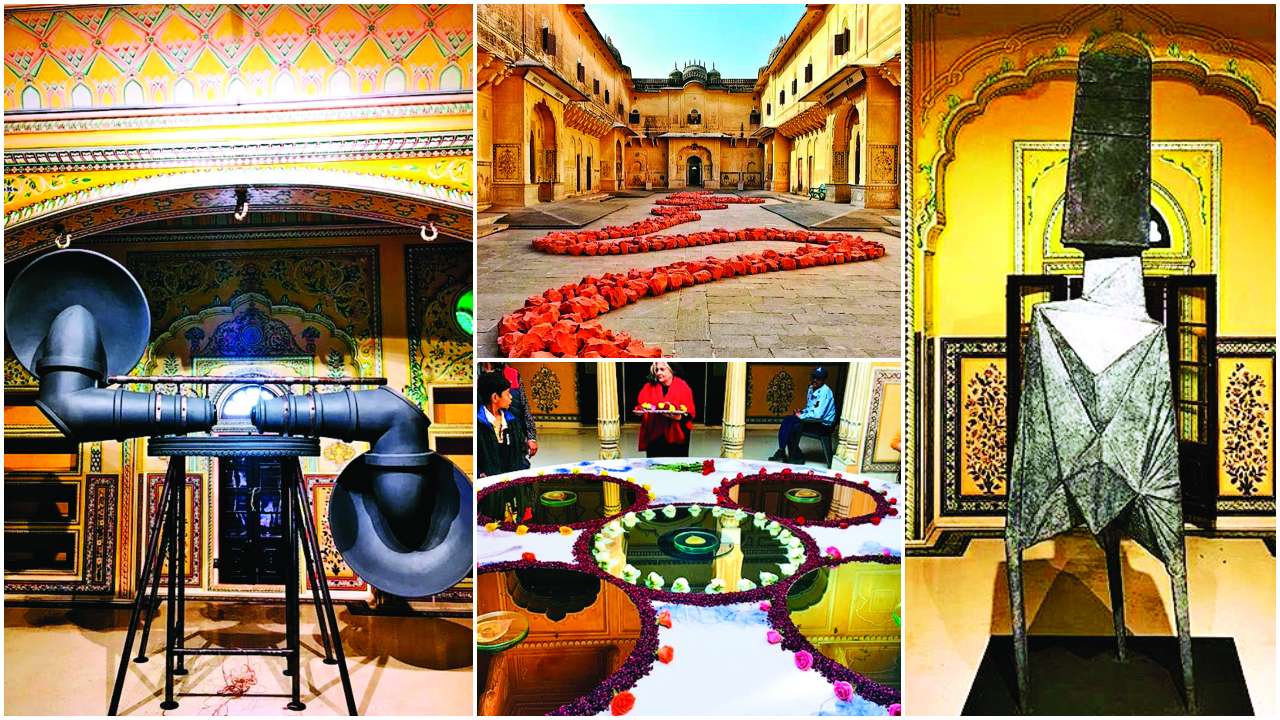
A little girl stands close to the thick band of red stones that meanders snake-like across the floor of the main courtyard of the 18th-century Madhavendra Palace. She lifts a foot, inching gingerly towards the stones, as if wondering – should she jump? Would the security guard scold her if she did?
A little further up, a group of tourists have just walked in and look askance – what is this?
Near them, a few boys – college students – sit on their haunches examining the stones, as if looking closely at them will make the stones yield their secrets.
Their mystification is understandable – it's not every day that they, ordinary folk who probably have never been to a gallery, get to see the kind of 'contemporary art' that metropolitan connoiseurs ooh and aah over. And the chances of seeing art by Richard Long the pioneering, 75-year-old, Turner-prize-winning land artist, who has made the work titled River of Stones? Slim indeed.
Which is probably what makes the Sculpture Park at Madhavendra Palace, a part of Nahargarh Fort in Jaipur, so unique. A venture of the Rajasthan government and Saat Saath Arts Foundation, a not-for-profit, supported by several corporate sponsors and curated by Peter Nagy of Nature More Gallery in Delhi, it's India's first contemporary arts gallery located in a nearly 300-year-old heritage structure. More importantly, it's one of the few places in India where contemporary art is displayed in an open-to-the-sky setting, in an ambience that is accessible, and promotes engagement with the artwork.
It's had an effect on the palace's popularity with visitors rising 37 per cent since last year, when the initiative began. Into its second edition now, the Sculpture Park unveiled a fresh set of artworks in mid-December by artists eminent and upcoming, young and old, Indian and foreign. The showpiece is Long's on-site installation – his first exhibition in India – that dominates the courtyard. It is made of locally found red sandstone broken into small-ish pieces and arranged in the shape of a river. The work, says Nagy, "activates the space", its point being the "contradiction between these very heavy stones turned into something that's almost liquid".
Then there's Lynn Chadwick, British sculptor, whose High Hat Man is the most expensive artwork at Madhavendra Palace; senior Bangladeshi artist Mahbubur Rahman's half-man, half-bull stainless steel sculpture Transformation that stands sentinel in one of the apartments off the courtyard; among others. Also included are two foreigners who've made India their home – Achia Anzi, from Israel, and Mark Prime, who's originally British.
Among the Indians are a pick of mid-career artists such as Reena Saini Kallat; LN Tallur, Manisha Parekh, Asim Waqif; and younger names like Shreyas Karle, Hemali Buta, Savia Mahajan and Tanya Goel. Conceptual, all the rage in the Indian art world, dominated, though many of the works had a presence that viewers could relate to over and above the concepts they embodied. Saini-Kallat's Chorus, for instance, looks like a strange mechanical device, which it is being too World War II-era listening devices between which viewers must stand to hear bird calls of two warring nations where they're found. Or Tallur's Chromatophobia – a giant seated Buddha cut in two neat halves with "Made in China" written on one half and "Made in USA" in the other.
But others, such as Chrysanne Stathacos's Five Mirrors of the World had viewers wondering what to make of it, even though they gamely went along accepting the roses that the Canadian-artist was distributing as part of her interactive installation. Most of them would never turn down such a strange offering from a foreigner – even if few realised they were being part of an art project.